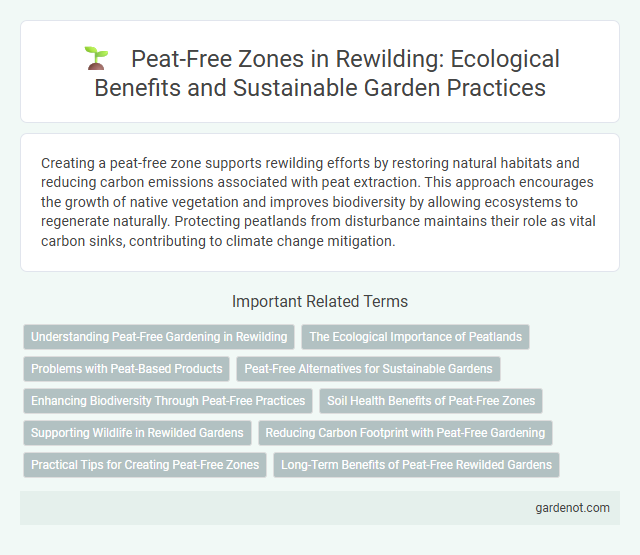Creating a peat-free zone supports rewilding efforts by restoring natural habitats and reducing carbon emissions associated with peat extraction. This approach encourages the growth of native vegetation and improves biodiversity by allowing ecosystems to regenerate naturally. Protecting peatlands from disturbance maintains their role as vital carbon sinks, contributing to climate change mitigation.
Understanding Peat-Free Gardening in Rewilding
Peat-free gardening plays a critical role in rewilding by promoting soil health and preserving biodiversity in peatland ecosystems. Utilizing alternatives like coir, bark, and compost reduces carbon emissions associated with peat extraction and supports the restoration of native habitats. Implementing peat-free practices helps maintain water retention and nutrient cycling essential for thriving, self-sustaining landscapes.
The Ecological Importance of Peatlands
Peatlands act as crucial carbon sinks, storing more carbon than all the world's forests combined and helping mitigate climate change by preventing greenhouse gas emissions. These ecosystems support unique biodiversity, including specialized plant and animal species adapted to waterlogged, acidic conditions. Creating peat-free zones reduces peat extraction, preserving these vital habitats and enhancing rewilding efforts to restore natural ecological balance.
Problems with Peat-Based Products
Peat-based products contribute significantly to habitat destruction and carbon emissions, exacerbating climate change while depleting vital wetlands. The extraction process disrupts biodiversity, displaces native species, and reduces natural water filtration, harming ecosystems. Transitioning to peat-free alternatives helps restore ecological balance and supports global rewilding efforts.
Peat-Free Alternatives for Sustainable Gardens
Peat-free alternatives such as coconut coir, composted bark, and green waste compost provide sustainable options for gardening that reduce environmental damage associated with peat extraction. These materials improve soil structure, moisture retention, and nutrient availability while promoting biodiversity and protecting peatland ecosystems. Adopting peat-free products supports rewilding efforts by conserving crucial carbon-storing peatlands and enhancing natural habitats.
Enhancing Biodiversity Through Peat-Free Practices
Implementing peat-free zones significantly enhances biodiversity by preserving native habitats and preventing the degradation caused by peat extraction. Peat-free practices support a diverse range of flora and fauna, promoting healthier ecosystems and facilitating natural rewilding processes. Restoring soil health and water quality in these areas further encourages the return of endangered species and boosts overall ecological resilience.
Soil Health Benefits of Peat-Free Zones
Peat-free zones significantly enhance soil health by preventing the depletion of vital organic matter and preserving biodiversity in local ecosystems. These zones promote improved soil structure, increased water retention, and higher microbial activity, which are essential for sustainable land regeneration and carbon sequestration. Maintaining peat-free soils supports resilient habitats and reduces greenhouse gas emissions associated with peat extraction.
Supporting Wildlife in Rewilded Gardens
Creating a peat-free zone in rewilded gardens significantly enhances habitat quality by preserving natural soil structure and moisture essential for native flora and fauna. This approach supports diverse wildlife populations, including pollinators like bees and butterflies, by promoting native plant growth and reducing carbon emissions linked to peat extraction. Maintaining peat-free areas contributes to healthier ecosystems, ensuring sustainable biodiversity and improved resilience against climate change.
Reducing Carbon Footprint with Peat-Free Gardening
Peat-free gardening significantly reduces carbon footprints by eliminating the extraction of peat, a major carbon store released during harvesting. Utilizing alternatives like coconut coir, composted bark, or leaf mold promotes soil health while preventing greenhouse gas emissions linked to peatland degradation. Establishing peat-free zones supports carbon sequestration and fosters sustainable rewilding through eco-friendly soil management practices.
Practical Tips for Creating Peat-Free Zones
Creating peat-free zones starts with selecting alternative mulches such as coconut coir, bark chips, or leaf mold to maintain soil moisture and fertility without damaging peatlands. Incorporate native plants adapted to local soil conditions to reduce the need for peat-based soil amendments and support biodiversity. Regularly monitor soil health and moisture levels using organic matter and compost to improve structure and nutrient content sustainably.
Long-Term Benefits of Peat-Free Rewilded Gardens
Peat-free rewilded gardens enhance biodiversity by restoring natural habitats and supporting native flora and fauna, resulting in healthier ecosystems. These gardens reduce carbon emissions by preserving peatland carbon stores and preventing further peat extraction, contributing to climate change mitigation. Over time, peat-free practices improve soil health and water retention, promoting sustainable land management and resilience against environmental stresses.
Peat-free zone Infographic

 gardenot.com
gardenot.com